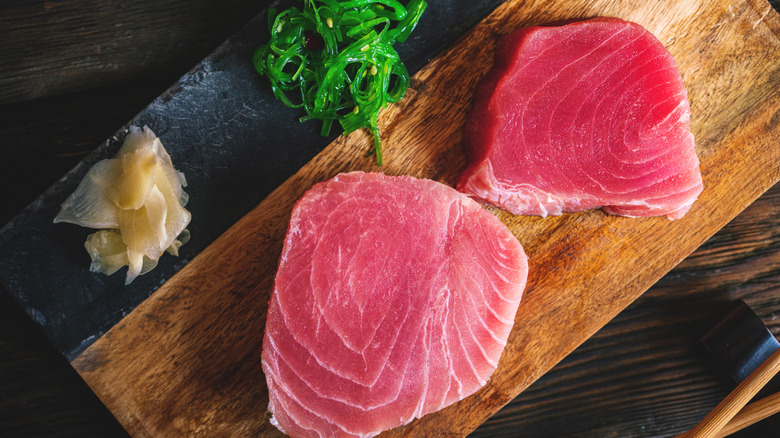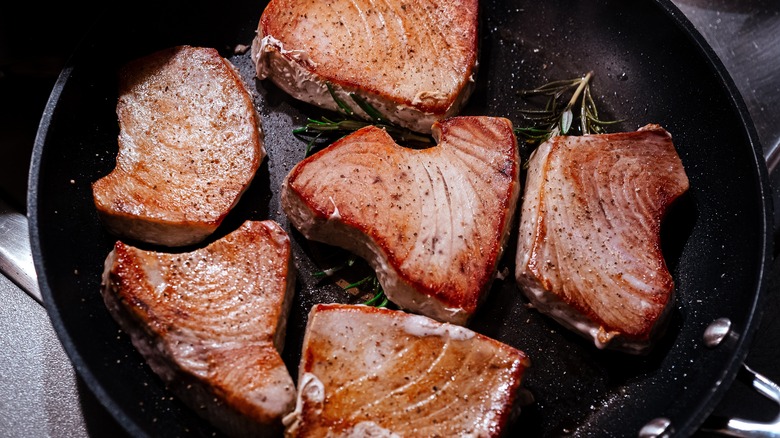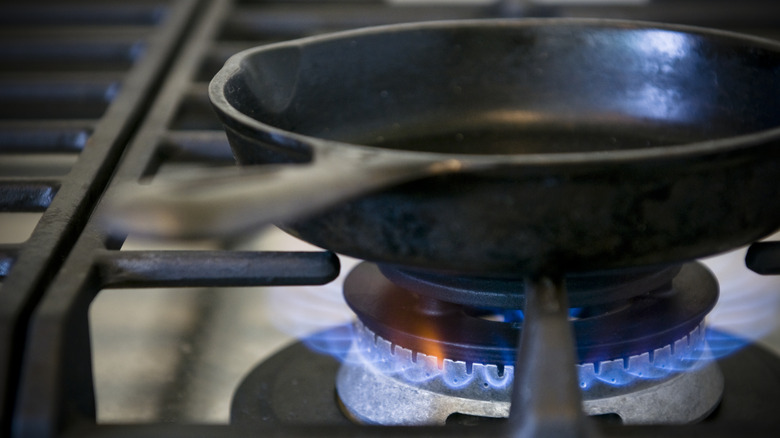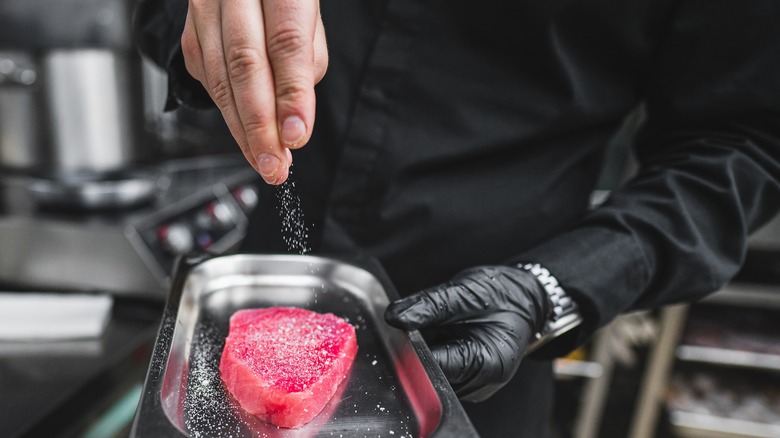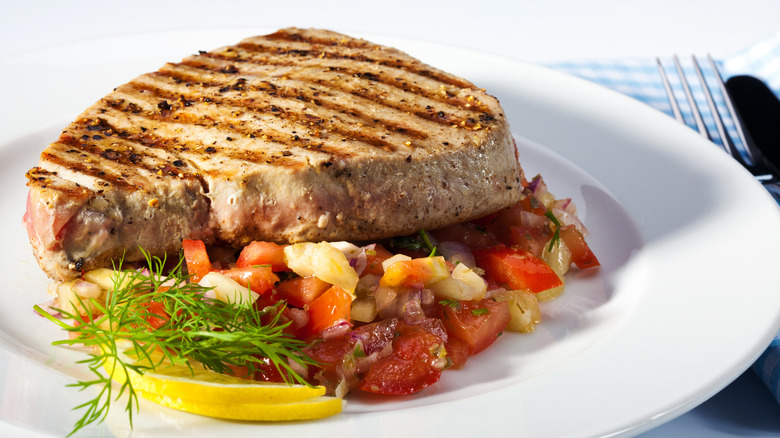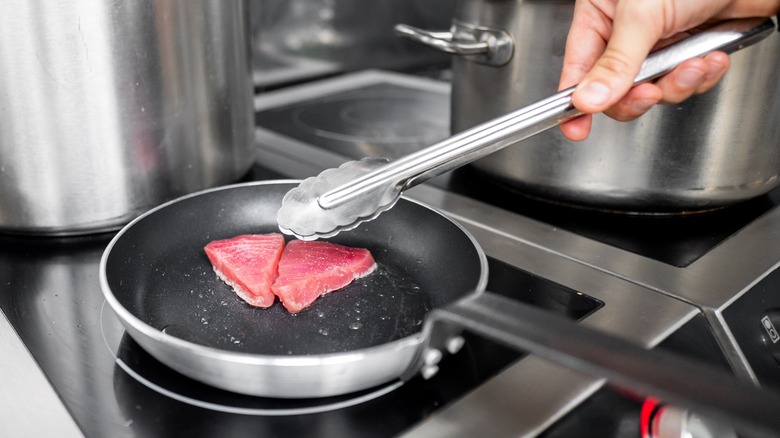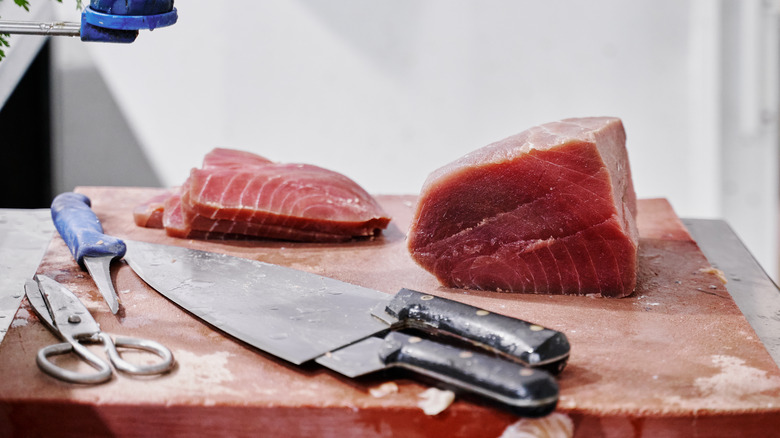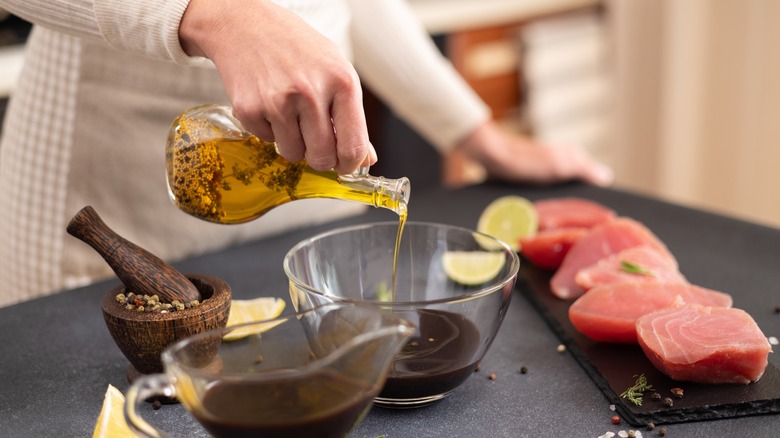9 Mistakes Everyone Makes When Cooking Tuna Steaks
While we're all familiar with flakey canned tuna and delicate, raw fish prepared as sushi, we don't typically think of the giant, ocean-faring fish when we think of steak. But if you're looking to put beef on the back burner (so to speak) in search of a heart-healthy dinner option, tuna steak is your best friend. They are chock-full of vitamins and nutrients, while being relatively low in calories, and can act as a blank canvas for chefs to experiment with tasty tuna steak recipes, seasonings, or cooking techniques. Plus, their tender, meaty texture and bright taste is second to none.
For those used to preparing beef steak — or even starting completely from scratch — choosing and preparing a tuna steak can feel intimidating. In an effort to ease your oceanic woes, I've teamed up with two highly-experienced chefs to find out the most common mistakes home cooks often make when preparing tuna steaks. Chef Evan Hennessey — owner of Stages at One Washington and The Living Room in Dover, New Hampshire — and Chef Jim Haurey — owner of The Grange in Warwick, New York — are no strangers to fish in all its forms. Here, they share their tips for avoiding the potential pitfalls that often befall home cooks when preparing tuna steaks.
Overcooking them
Arguably the most important rule of thumb when cooking tuna steaks is to be extremely mindful of the steak's time on the grill or in the pan. Overcooking a tuna steak can have disastrous consequences, and this mistake can't be rectified outside of purchasing a brand new steak and starting the process over again. "The success of cooking tuna is based on the ability to retain moisture in the fish, which is how the flavor is translated," says Chef Hennessey. "Generally, when people cook [tuna steaks] it's done on very high heat, which is a dry heat method, and when left on this heat for too long, it can quickly create an undesirable and dry texture and flavor."
While there's nothing wrong with liking your tuna steak well-done, according to Chef Haurey, tuna steaks are typically served on the rarer side. This helps the steak retain moisture and its signature melt-in-your-mouth texture. Chef Haurey explains that you can cook a tuna steak well-done if you prefer it that way, but it will be tougher than a rare or medium-rare tuna steak. Once it's gone beyond the well-done mark, the tuna steak has reached dried-out territory.
Not getting the pan hot enough
This step is easy to overlook and tricky to get right. Before plopping your tuna steak in the pan, it's important to make sure that the pan has been heated thoroughly, but that it isn't too hot. A pan that's not sufficiently hot won't give your tuna steaks a thin and crispy sear. When the pan isn't hot enough, the steaks cook slowly and can result in a mushy, chewy meal. Chef Hennessey suggests using a cast iron pan, such as the Lodge Cast Iron Skillet, to cook your tuna steaks, and preheating the pan over medium-high heat. If the heat is too high, your steak could potentially stick to the pan, removing the desirable crust on the outside.
To test if your cast iron pan is hot enough to cook tuna steaks to perfection, toss a few drops of water into the pan once you suspect that it's been sufficiently heated (this may take about 5 minutes). If the droplets of water form beads and then pop and fizzle out into steam, your pan is ready to go. If the water immediately evaporates, then the pan is likely too hot. You can also check the temperature of the pan using cooking oil. Chef Haurey says that once small wisps of smoke appear on the surface of the oil, it's time to add the steaks to the pan. He explains that you should lift the fish up to make sure that the entire surface is touching oil.
Choosing the wrong seasoning
Although tuna has a relatively neutral flavor profile — with its texture doing most of the heavy lifting in terms of its notoriety in the world of seafood — some flavors don't mesh well with it. Heavily smoky and sweet tastes, like barbecue sauce or sugary, fruit-based glazes, don't complement tuna's natural fishy essence. Dairy-based sauces can also distract from its delicate flakiness and fresh taste. So, when preparing your first tuna steak, be sure to skip the sauces and seasoning that you'd normally use when cooking classic beef steak and explore a new world of flavor possibilities.
"So many flavors go with tuna, it's really a great vehicle," says Chef Hennessey. "I prefer to keep the outside seasoning simple with heavy salt and pepper, then add more flavor on top ... One of my favorite things to do is sear the tuna on the grill or wood fire, then smother in chimichurri. It's the perfect blend of herbs, spices and smoke." When asked what flavors go best with tuna steaks, Chef Haurey said, "Personally, salt and pepper is all you need. Tuna is big in Mediterranean food; olives, tomatoes, greens, feta, thyme, basil, lemon, and olive oil. Keep it light and fresh!"
Not seasoning first
If you plan to use seasoning to spice up your tuna steaks, it's best to add it before dropping the steaks in the pan. First, create your seasoning by mixing your preferred blend of herbs and spices together, or purchase a pre-made seasoning mix, such as Frontier Co-Op Seafood Seasoning, designed for tuna steaks. Then, rub the seasoning onto both sides of each steak. Seasoning your tuna this way allows it to capture and absorb the flavor from the spices and maintain an evenly-distributed taste throughout the steak.
Once your tuna steaks are adequately seasoned, add them to a hot pan with oil. Try a seasoning rub of freshly-grated ginger and garlic, lemon, coriander, salt, pepper, and toasted sesame seeds. Make sure to press the fresh ingredients into each steak, and try cooking them in sesame oil. You'll find that the grated ginger and garlic forms a slight char as the tuna is seared, adding just a hint of smoky flavor to the aromatics.
Overseasoning them
While tuna steaks act as an ideal canvas for exploring new flavor potentials, part of their appeal is their naturally piquant taste. Overseasoning has the potential to eradicate the tuna's sweet, bright, and zesty flavor, highlighted by its tender, melty texture. Excessive spices can overshadow the delicate nuances in its natural flavor and impart a gritty texture, effectively ruining its soft mouthfeel.
Instead of going buck-wild with the seasoning or marinade on your tuna steaks and adding bold flavors — like overly tangy, spicy, or sugary ingredients — try lightly seasoning and choosing ingredients that pair well with tuna's natural taste profile. A hint of citrus livens up tuna's vibrant essence, and just a little black pepper and garlic acts as a powerhouse of bold flavor to accentuate the natural sweetness in the fish. If you're not feeling confident in your seasoning game, pick a sauce that pairs well with tuna and dollop it on post-grilling, being careful not to smother the fish, taking away from its cherished texture.
Cooking them to the wrong temperature
The temperature at which tuna steaks should be cooked is determined almost entirely by preference, outside of overcooking them. That being said, if you're after a bright-tasting, ultra-tender steak, cooking your tuna on the rarer side is ideal. If you're aiming for a steak that's slightly tougher and more savory, try cooking your tuna medium-well or well-done. "A well-done steak has a very different flavor than a rare steak," says Chef Haurey. "It will be richer and deeper."
"I believe the perfect temperature for tuna steaks is right between the rare and medium rare mark," says Chef Hennessey. "It takes the fish just a touch away from cold in the middle and still retains all the moisture and flavor." To achieve what Chef Hennessey describes as the ideal temperature for tuna steaks, cook them for 1 minute on each side, checking that their color has changed on the outside from reddish-purple to beige. Before removing the steak from the pan, use an instant-read meat thermometer, like the Doqaus Digital Meat Thermometer, to check the internal temperature of the tuna. It should read about 65 or 70 degrees Fahrenheit. Tuna steaks usually climb in temperature after being removed from the heat, so the final product should yield a steak that's about 90 degrees in the center — not cold, but still pink and juicy, the way they're meant to be.
Not patting them dry before cooking
While this step seems trivial, it's actually one of the most significant steps in the tuna-cooking process. Whether you use fresh or frozen steaks, they're likely going to be very moist to the touch. "When any protein is moist, it creates a blast of steam when it hits the hot pan," explains Chef Haurey. "Not only does this make a mess and possible flame up, but the steak will most likely stick and take much longer to get a good sear."
Chef Hennessey also provides his two cents: "If there's too much moisture on the outsides, when it comes into contact with the cooking surface ... there will be less of a chance to properly sear the fish and ... get that perfect crackly crust." He goes on to explain that this is the case for all types of fish, so always be sure to thoroughly dry your filets and steaks before they hit the heat.
To dry tuna steaks, simply pat them with paper towels until most of their moisture has been absorbed. Don't expect the steaks to feel bone dry; instead, they should feel slightly wet, but without any obvious beads of moisture on the outside. Be sure to complete this process before adding seasoning or using a marinade.
Choosing the wrong cut
Not all tuna steaks are created equal. While most cuts of tuna will be about an inch thick, they can vary in size. Freshness also plays an integral role in whether your tuna steak will make a delicious meal or render your dish lackluster. Chef Hennessey says to check first for the color of the tuna steak. A fresh steak will be a brilliant ruby red color, with little to no gray or brown hues. Colors differentiate slightly depending on whether the steak is from a bluefin or yellowfin tuna. He goes on to explain that the second thing to look for is the thickness of the steak. A steak that's too thin will overcook quickly before a crispy sear can form. Conversely, a steak that's too thick will take longer to cook, resulting in a dried out piece of fish. It's best to aim for a steak that's about 1-inch thick.
Chef Haurey also explains that checking for any odor is an easy way to determine the freshness of a tuna steak. "Fresh tuna won't have much smell," he says. "A faint hint of blood, or, more accurately, the iron in the blood, is about all you should smell."
Not using a marinade or brine
Although tuna steaks are delicious with only a touch of salt, pepper, and a bold flavor like citrus or garlic, a marinade or brine can take them to new heights. Brining tuna steaks breaks down their short muscle fibers, making the meat even more tender and melty than it is in its natural state. The process only takes about 15 minutes (a much shorter length of time than the process of brining beef or chicken). To brine tuna steaks, soak them in a solution of about 5 tablespoons of salt in 2 quarts of water before tossing them in the pan.
Additionally, seasoned marinades add deep, rich flavors to tuna steaks and impart benefits to their texture. "Tuna is a great flavor vehicle," says Chef Hennessey. "It adapts to and absorbs basically anything. You can marinade the fish and simply dice it raw for poke, or cook it quickly afterwards and use the marinade as a basting sauce on the grill."
Chef Hennesey goes on to explain what flavors in marinades work best for tuna: "I love any marinades that are a perfect blend of lots of herbs and acids with a hint of something funky behind it, like black garlic or a shot of oyster sauce. For example, a nice marinade of fresh mint and basil with lime zest, sichuan pepper and black garlic is wonderful." Avoid marinades made with excessive amounts of sugar or honey, because these ingredients can quickly burn on the high-heat grill or pan.
